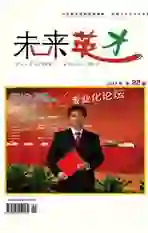Chongqing’s Economic Challenges in Early 2000s and the Governmental Policy Solutions
2017-11-22HanxiaoLiu
Han+xiao+Liu
ABSTRACT:Despite the prominent administrative status of Chongqing as one of the four Direct-Controlled municipalities in China, little economic development has been seen in the region historically. Up until 2002, and a few years following that time frame, the regional development has been staggering with lower than average GDP growth rates and urbanization rates. Since then, the city has seen dramatic economic growth even at times of global financial crisis in 08 and 07 when global growth was plummeting in even the fastest growing regions prior to the crisis. This research has attempted to acquire a better understanding of the propelling forces behind such success through review of existing literature and data provided by the Chongqing Urban Planning Exhibition Hall.
KEY WORDS:Regional Development;Industrial Upgrade;Rural-Urban Integration;Investment Financing.
The gains of economic development in Chongqing has been stagnating throughout the better half of the late 20th century. In the early 2000s, however, Chongqing has witnessed significant economic growth as instantiated in the 14% annual increase of GDP in 2008, the year when the global financial crisis resulted in massive declines in growth across the world(Li 2014, 83). This report, through examination of policies of the local government and results of Chongqings development, contends that the economic growth during this early 2000 period of Chongqing has been a result of the successful identification of obstacles to economic development in Chongqing, the effectively implemented policy solutions to these problems and the implementation of growth-promoting industrial policies.
Problems Facing Chongqings Economy in Early 2000s
There were two major problems hindering the development of Chongqing in early 2000s: the primitive industrial composition and a wide income gap between city dwellers and peasants in rural areas (Li 2014, 83-85).
The primitive industry composition further restricts the path of development. Primary and secondary industry dominate the economy of Chongqing. Heavy industry such as steel production contributed to a huge part of the economy in early 2000s. Automobile and motorcycle also made up as much as 30% of the local GDP (Li 2014, 87). The problem of the second industries in Chongqing is energy inefficiency. Automobile and motorcycle assembly consumed in early 2000s as much as 70% of the commercial electricity in Chongqing yet only contributed to less than 30% of the local GDP (Li 2014, 87).endprint
In terms of the rural population, more than half of Chongqings territories are filled with rural and agriculturally-focused villages. Although agriculture does not account for a major portion of the GDP, the massive below-povertylevel population in the rural areas has proven to be an obstacle for many villages to develop. On average, rural areas residents have much lower income compared to city dwellers. By 2007, Chongqing had 15 million rural population, 3 million residents below poverty levels and half million-people living in “absolute poverty (Li 2014, 85).”
Policy Solutions of the Local Government and the Results
The government reconstructed the industry composition of Chongqing through upgrading existing industries and introducing novel industries. The government maintained the existing advantage of the city on heavy metal production and auto/motor assembly. On top of that, the government encouraged market upgrade and shift of these traditional productions to be more energy efficient and more environmentally friendly. In the case of Chongqing Iron and Steel Company, the government provided 75 billion yuan to acquire its existing land so that the company can move to a new location where it will create less pollution (Li 2014, 102). Furthermore, the government also encouraged the company to abandon its traditional market of construction steel production and shifted to the higher valueadded ship and auto steel production.
In terms of developing new industries, the government has deeply committed on attracting new industries with growth potential to the extent that the mayor and party secretary would personally and actively negotiate with corporations to move parts of production to Chongqing. These negotiations resulted in electronic manufacturers like HP, Acer and ASUS to move their production partially to Chongqing to take advantage of the labor cost and convenient transportation through Yangtze river which would allow finished products to be allocated both nationally and, through ports in Pearl River Delta, globally (Huang 2010).
With regard to the massive rural population, the local government has primarily focused on industry cultivation. The government also actively promoted newer and more profitable industries in these rural localities. In the Chongqings northeastern and southeastern territories, the government promoted many new industries that suit the local conditions (Chongqing Urban Planning Exhibition Hall tour, July 2017). The local government introduced industries such as food processing in these areas. The industry of food processing takes advantage of the locally available food materials harvested from farms(Chongqing Urban Planning Exhibition Hall tour, July 2017). These new measures in rural areas resulted in a spike of income of rural residents.endprint
In conclusion, while Chongqing faced some serious challenges to its economic development prior to 2002, the government has since then instituted effective measures to resolve them. Although long term effects of the policies are hard to estimate given most of them have only been implemented for around a decade, the immediate result is a strong economy that managed to grow more than 10% in GDP in the 2007 and 2008, the years of financial crisis, and a continued annual GDP growth of 10% in the following years up to 2016 (Li 2014, 83). Perhaps most significant of all, is the drastic decline in numbers of those living under poverty, with seven counties rising above the poverty line. These results demonstrate that the strategy of development in Chongqing has been fruitful and worth reviewing for regional economic development.
參考文献
[1] Chongqing Urban Planning Exhibition Hall tour, July 2017.
[2] Huang, Qifan. 2005. “投融资体制改革 重庆模式的‘抓手.” Securities Daily. Feburary 1, 2005 Issue.
[3] Huang, Qifan. 2010. 2010重庆发展策略总览. Speech record.
[4] Li, Xiaobo. 2014. City Strategist. Beijing: China Development Press.endprint
